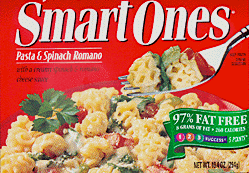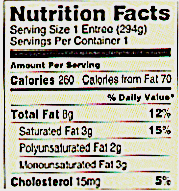 Food Labels that Fool You! Food Labels that Fool You!
If it's 97% Fat Free, does that mean 3% of
the calories come from fat? No, not even close! This product
actually contains 27%
fat!
So what's going
on?
In order to make
it easy to understand for the consumer, the Food and Drug Administration
established standardized guidelines to be used in the nutrition labeling - pay attention - I
said nutrition labeling, not the packaging - which all manufacturers
are required to follow. Using these guidelines, this product
contains a total of 27% fat based on calories.
So how then can
the manufacturer claim that this product is "97% Fat Free?"
Because that percentage is calculated using weight, not calories. And that's
allowed by the FDA because the packaging is not part of the nutrition
label. In other words, 3% of the weight of this product contains
fat!
Here's how the
manufacturer has computed the 97% fat free figures: The total
weight of this package (see Nutrition Facts below) is 294 grams
and the total weight of fat in the package is 8 grams, so 8 divided
by 294 = 0.027 x 100 = 2.7% or 3% rounded off.
What's wrong
with using weight to calculate percentage of fat? Fat is lighter than most
other ingredients, so you'll always get a low numerical value.
If you want to
know the percentage of calories you're getting from fat, you
must use
calories for your calculations, not weight. See for yourself! Here's
how to figure the percentage of fat using calories, the correct
way to calculate if you want to know how much fat you're consuming:
Using this same label, the total number of calories is 260. Calories
from fat totals to 70, so 70 divided by 260 = 0.269 x 100 = 26.9%
rounded off to 27% fat. This means that 27% of the calories in
this product come from fat.
Confused? There's
more!
When looking
at this label, did you think the total fat content was12%? Once
again, in their efforts to make it easy to understand for the
consumer, the FDA created a system called % (Percent) Daily Value. And what does that mean?
Percent Daily
Value is a measurement of how much fat you're getting from a
food product if you consume 2000 calories and 65 grams of fat
per day - and that would be easy to understand if all of us ate
2000 calories a day - no more and no less. This product contains
8 grams of fat which is 12% of 65 grams. But note, if you consume
less than or more than 65 grams of fat per day, the % Daily Value
listed on the label will not apply to you.
It's a good idea
to test your calculations against the manufacturers' claims.
When you start doing your own computations, you'll be surprised
to find food
labels that fool you
and a
lot of advertising that doesn't add up!
NUtritionTipS
-Here's another way to figure the percentage
of fat if the product doesn't offer the number of fat calories.
We'll use the Pasta & Spinach Romano label (right) as an
example.
-Multipy the number of grams of fat in one serving by 9 because
fat contains 9 calories per gram. Divide this number by the total
number of calories in one serving. Then multiply by 100 to get
the percent of fat. For example, if one serving contains 260
calories and 8 grams of fat, then 8 x 9 = 72 divided by 260 x
100 = 27% fat per serving.
For more information
and to request a copy of the Code of Federal Regulations governing
nutrition labeling of fat in food products, call the Food and
Drug Administration at 1-888-723-3366 and ask for Regulation
21CFR101.62, pages 102-111, or visit their website at www.fda.com.
Where do you get your nutrition
information? Most states now have licensure laws for Dietitians
and Nutritionists. Be sure your nutrition advisor is "Licensed"
by the State as a Licensed Dietitian (LD) or Licensed Nutritionist
(LN), or in states that don't have licensure laws, a Registered
Dietitian.
CarboH,
Inc.
Barbara Herondorf, L.D.
Home |
FAQ's |
Sample Menu |
Policies
More About CarboH |
Order CarboH |
Contact Us |
Letters
|


